History Matching
What is History Matching?
History matching is the process of building one or more sets of numerical models (representing a reservoir) which account for observed, measured data. During any kind of model calibration process such as this, it is important to note that:
- Reservoir models are models, not reality. There are inevitable errors and approximations that are found in any model of physical phenomena.
- The history matching process is undertaken for the purpose of decision making. History matching serves no purpose on its own.
- The model input is uncertain, and the uncertainty is almost always underestimated.
- The observable data always contains errors, however small.
History matching should be considered in the general context of uncertainty quantification, of which history matching is only a part. For proper decision making, the uncertainty of the outcome must be assessed. The assessment of uncertainty is always subjective. History matching should assist in creating the model of uncertainty, which is subsequently used for decision making.
Generalized Reservoir Modeling Workflow
We examine history matching in terms of a general reservoir modeling workflow, shown schematically in the figure below. There are several basic elements to reservoir modeling that most (of not all) workflows have in common. First, at least one if not many reservoir models are constructed, each requiring model parameters. The engineer (or geo-scientist) varies the parameters through sensitivity runs. Sensitivity analysis is the process of learning from these runs to determine which model parameters have a significant impact on the model responses. Screening is is the process of model selection, which may be iterative, requiring more models to be built by resampling the model parameters. The model refinement step takes the models selected through screening and refines them before reaching the final step in the workflow, which is often forecasting future production from the reservoir.
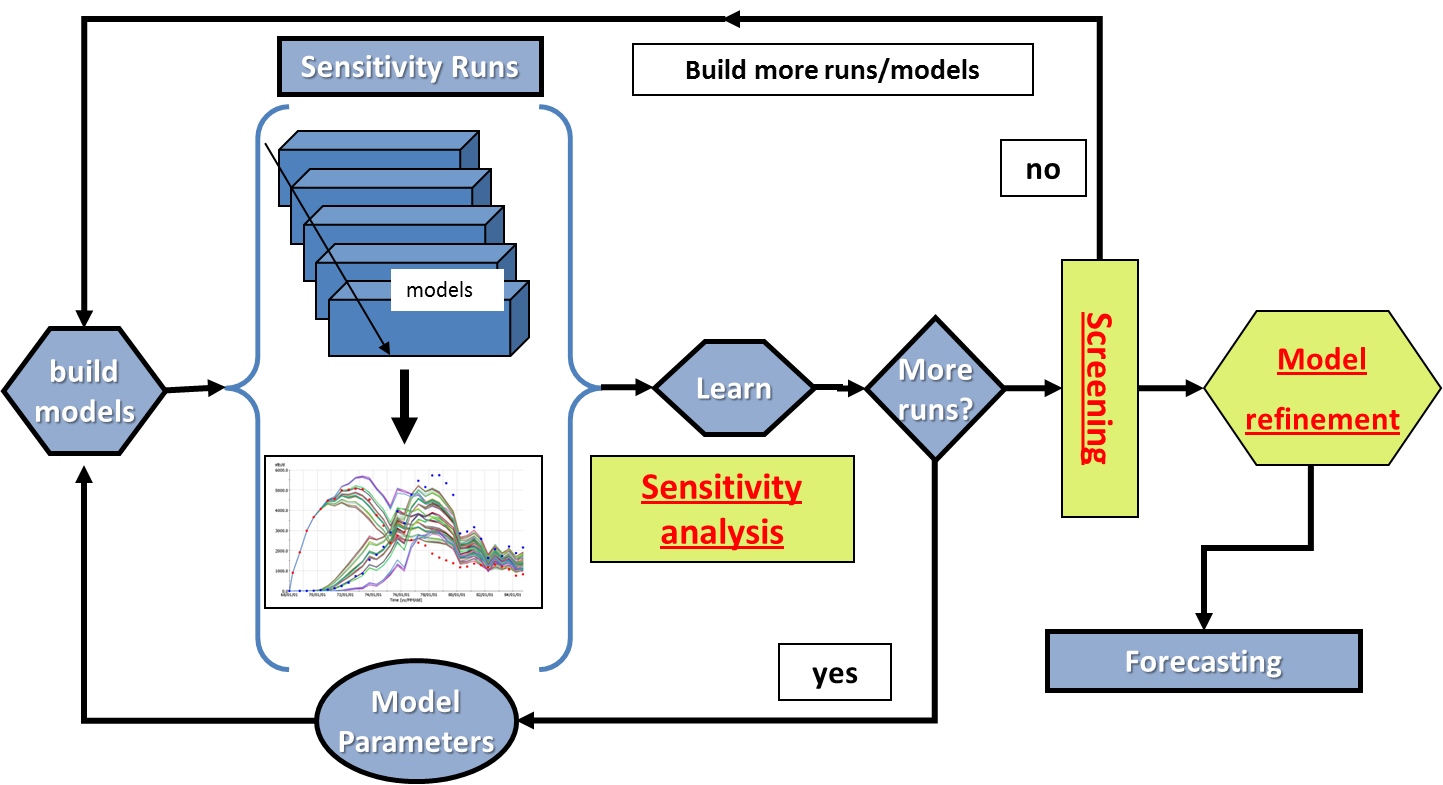 |
Schematic diagram of general modeling workflow including the following elements: Parameters, Sensitivity Runs & Analysis, Screening, and Model Refinement.
History matching in its essence is the selection of reservoir models which best match the reservoir data (static and dynamic). It can really be seen as the screening step, followed by model refinement. In traditional approaches, screening is often performed by a geo-scientist, who selects only a single model without considering the historical production (only static data). The model refinement is the task of the reservoir engineer to match the single model to historical production data. This manual history match process is extremely time consuming, and often the model refinement would result in a model which is significantly different from the model selected by the geo-scientist through screening.
Promoters of sophisticated (and expensive) history matching software packages often assert that the sensitivity analysis, screening, and model refinement steps can all be done in one single black-box approach. However, the truth is that no single approach is appropriate for all circumstances. What is especially important is not necessarily the history matching method, but the parameterization of the reservoir model, and the workflow used to construct reservoir models during history matching, which is discussed below.
Reservoir Modeling Workflow
As described above, traditional manual history matching involves modification of the fluid flow model during the model refinement process. Although it is currently well understood that history matching requires an interdisciplinary approach which should involve a team of geo-scientists and reservoir engineers, this traditional approach is still often employed in assisted history matching methods. This workflow is depicted in the diagram below (left). First, the geological model is created, which is the basis of the fluid flow model (perhaps requiring an upscaling step between the geomodel and flow model). The flow simulation is run and history matching modifications are applied on the flow model. This approach can have several drawbacks, notably:
- Any modifications to the fluid flow model are not carried back to the original geological model and may not be consistent with the geological data which has been used to create the geological model
- Only parameters and properties in the fluid flow model can be modified. Any uncertain parameters in the geomodel cannot be directly modified in the history matching workflow.
Only in the recent decade have researchers and software providers attempted to incorporate the geological modeling process within the history matching loop. In this workflow, the history matching algorithm can modify uncertain parameters in both the geological model and the flow model. This workflow resolves some of the problems mentioned above, and is a workflow which (one would expect) can lead to better history-matched models. However, it is more difficult to implement.
Schematic Description of Traditional and Modern History Matching Workflows
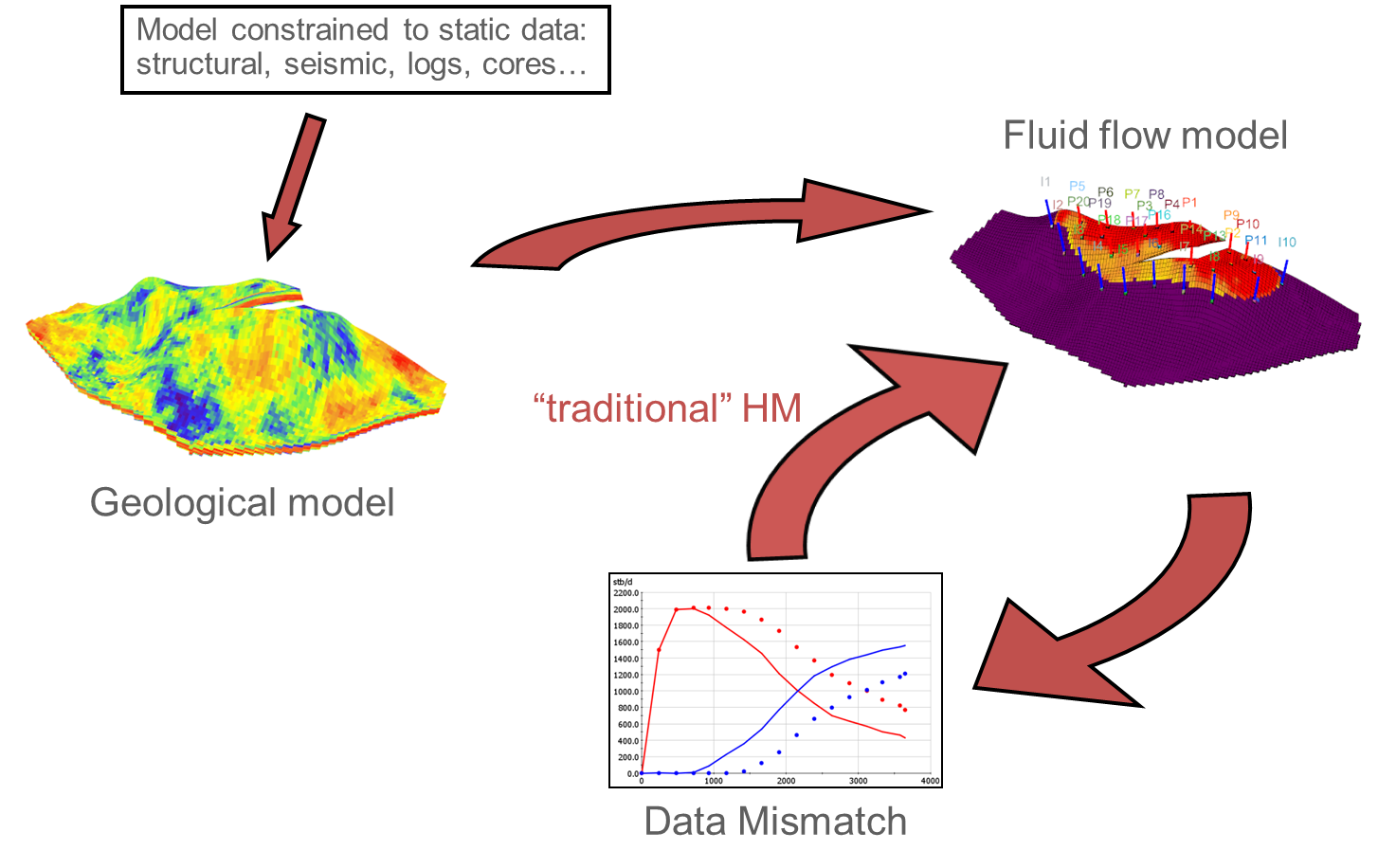 Classical HM Workflow Classical HM Workflow |
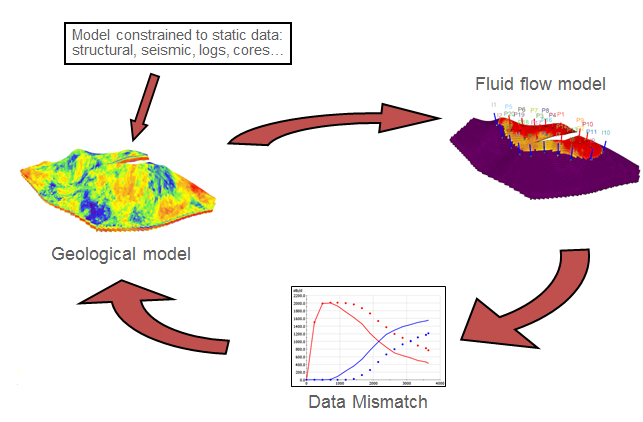 HM Workflow Integrating G&G and Flow Model HM Workflow Integrating G&G and Flow Model |
Regardless of the history matching workflow, the reservoir engineer and geomodeling team have several important tasks that no assisted history matching method should do automatically:
- the interpretation of reservoir data,
- the parameterization of the the reservoir model(s), and
- the decision about the uncertainty of the input parameters and reservoir data.
These tasks are necessarily subjective decisions and have extreme importance on the quality of the model (and hence the history match). Clearly, the interpretations, assumptions, and decisions of the geomodeling team which ultimately lead to a numerical model of the reservoir should be challenged and questions during the modeling process. And ultimately, the failure in history matching is more often due to incorrect interpretations, assumptions, and decisions by the modeling team, rather than a bad assisted history matching method.
Model Refinement
For complex, multi-well reservoir models, one may often find after history matching that a certain number of wells do not match the historical data. This often occurs in reservoirs with displacement processes (like waterfloods), where inter-well properties are important in determining production of fluids. In this case, the engineer may wish to refine the history match by changing the petrophysical properties of the reservoir model between injector and producer pairs. There are several difficulties with this procedure. The engineer must know where (in what grid blocks) to modify the petrophysical properties, and by how much to modify the properties. The engineer must also ensure that the modifications are consistent with the underlying geological data which was used to create the model (spatial correlations, facies interpretations, histograms, seismic data).
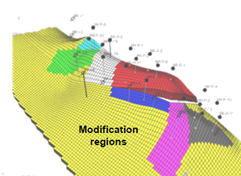
This final constraint is often ignored in practice. However, ignoring the geological data may result in poor predictive models. For example, the figure on the right shows a model where multiplication regions are defined. Typically, the engineer defines these regions and then manually (or through assisted history matching) modifies the permeability and/or porosity to match well data lying within the region. Although this may result in a history match, one may ask whether these regions, and their multipliers, have any sense geologically. It would be better to have modifications which remain consistent geologically, leading to better confidence in predictions. Geologically-consistent history matching addresses the question of how to integrate production data consistently with other sources of data (such as core samples, geological intuition, seismic, well tests, etc.) |
Geologically-Consistent History Matching
What is geologically-consistent history matching?
Geologically-consistent history matching is:
- The treatment of the history matching problem as a data integration problem, not an optimization problem
- The accounting of dynamic data in the geomodeling process in a probabilistic manner consistent with static data
- A subjective judgment about what is fixed (i.e. known, eg. porosity histogram) and what can be modified (uncertain)
Some authors falsely claim that a particular history matching method is "geologically-consistent". A HM method is not automatically geologically-consistent if there is:
- A "prior" term or "smoothing" term in the objective function, or if
- G&G parameters can be modified in a HM loop.
The key idea in geo-consistent history matching is the use of probability models that account for ALL data during construction of geological model. This includes:
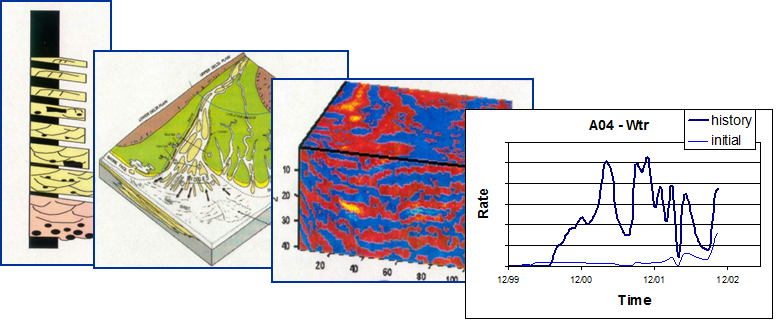
|
Most common history matching software (and research) do not approach the problem in this manner. The advantage of this approach is that any data redundancy and inconsistency are handled in a systematic, probabilistic manner. Geostatistical methods can be used to derive these probability models.
References
- History Matching Standards; Quality Control and Risk analysis for Simulation”, Baker et al., Paper 2006-129 (2006 Canadian International Petroleum Conference)
Contact in USA
Corporate Headquarters 
StreamSim Technologies, Inc.
865 25th Avenue
San Francisco, CA 94121
U.S.A.
Tel: (415) 386-0165
Contact in Canada
Canada Office 
StreamSim Technologies, Inc.
Suite 102A - 625 14th Street N.W.
Calgary, Alberta T2N 2A1
Canada
Tel: (403) 270-3945
